On the last matchday of the FIFA World Cup group stage, most nations who had already qualified for the next round chose to rotate their starting eleven. This decision backfired in most instances though. France was the first, followed by Spain, Portugal, and now Brazil. The competitive gap is lower than ever before, with the tactical side of the game being one of the main reasons why.
Although some nations may not have the talented squads of the likes of Brazil, England, and France, they are still able to be extremely competitive, and in some cases, even overcome the favourites. This was the case in group G, where Cameroon defeated Brazil with a narrow 1-0 victory in the last match of the group stage.
With the Seleção already qualified for the knockout rounds, Tite chose to rotate his entire starting lineup. Nonetheless, this so-called B team still contained elite players like Liverpool’s Fabinho, Arsenal’s Gabriel Jesus, and Man United’s Antony. Cameroon, on the other hand, were virtually out of the competition. The combination of results needed was unlikely, so pride was the only thing left for the Indomitable Lions. Despite already going home, their victory over the title favourites will echo in the country’s World Cup history.
Brazil were superior both in possession and expected goals, but this did not translate into goals. Although they had the majority of the ball, they were unable to progress with control and danger. Rigobert Song deserves a ton of credit for assembling such a brave and effective defensive system. On the other hand, Brazil were underwhelming all around. The disappointing collective performance is a larger symbol of the low individual standards.
This tactical analysis will take a detailed look into the tactics behind this fascinating upset of Cameroon over Brazil. This analysis will first look at the tactics Cameroon used to frustrate the Seleção, before taking a brief look at some solutions Brazil offered. Finally, we will also look at how Cameroon faced Brazil with the ball, and how the Lions were able to find the edge in the 90th minute.
Lineups
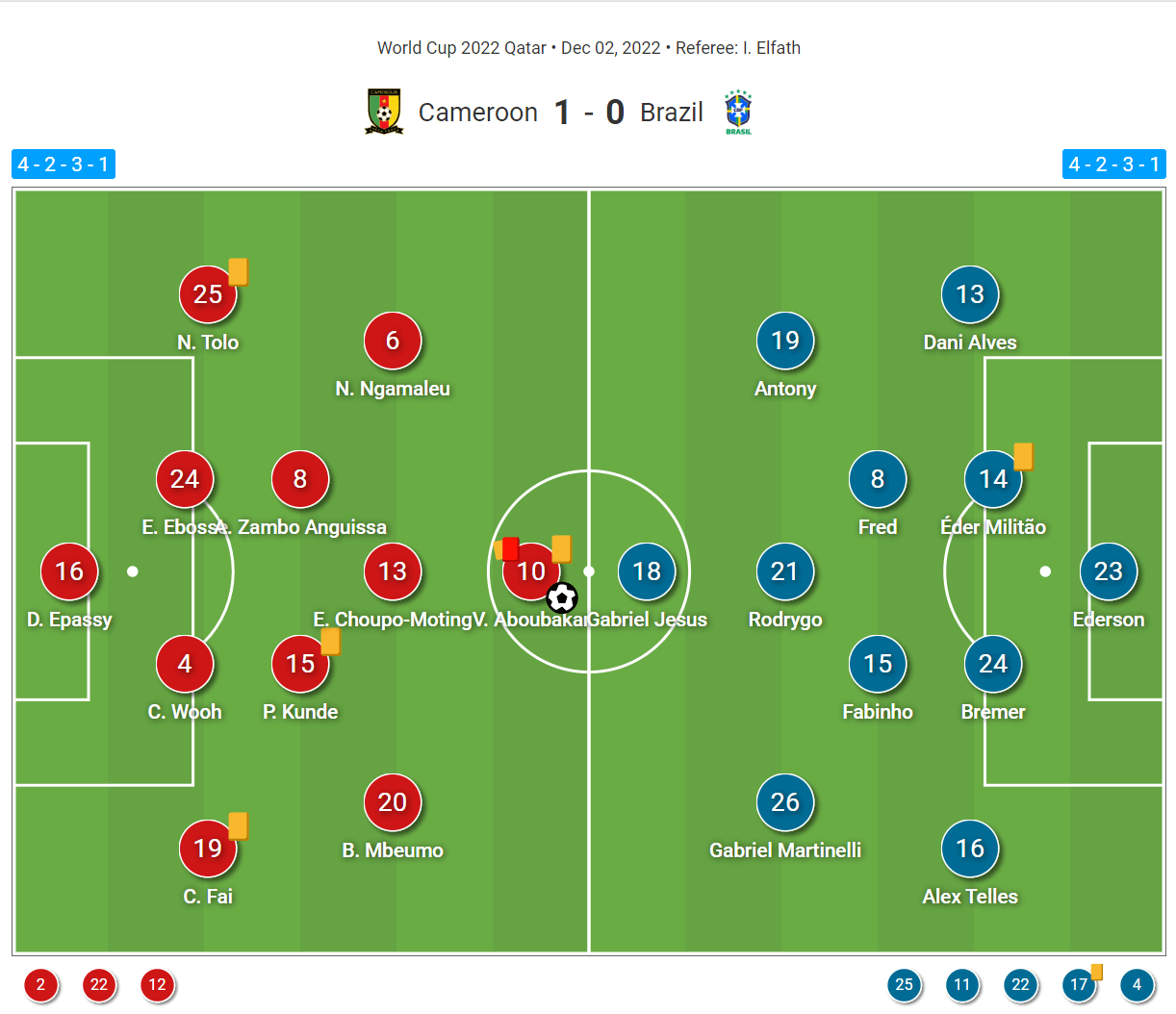
Let’s first look at how both sides lined up for this game. As mentioned, Tite rotated the entire starting XI for this match. They lined up in their usual 4-2-3-1 formation, but this is far from important as they are extremely fluid. Ederson was the goalkeeper behind a back four of Dani Alves, Éder Militão, Bremer, and Alex Telles. Unfortunately, Telles suffered an injury early into the first half and was replaced by Marquinhos in the 54th minute.
In the midfield, Fabinho and Fred were the deeper options behind a free-roaming Rodrygo. Fred and Rodrygo were both subbed off in the 55th minute for Bruno Guimarães and Everton Ribeiro, respectively. Although Rodrygo is usually a wide player, the 21-year-old’s profile is slowly becoming more central, similar to Neymar’s career trajectory.
The front three consisted of Gabriel Jesus flanked by Arsenal teammate Gabriel Martinelli and Man United’s Antony. Jesus was replaced by Pedro in the 64th minute, with both of them having rather disappointing performances. Antony was also replaced by Raphinha in the 79th minute.
For Cameroon, Song made four changes from their 3-3 draw with Serbia. Devis Epassy was still the goalkeeper, and the 29-year-old had a tremendous performance in this match. Collins Fai and Nouhou Tolo were the fullbacks while Christopher Wooh and Enzo Ebosse formed a centre-back partnership.
Frank Anguissa and Pierre Kunde were the two midfielders, with Bryan Mbeumo and Nicolas Ngamaleu on the wings. Up top, Eric Maxim Choupo-Moting was more of a false nine alongside Vincent Aboubakar. Lyon’s Karl Toko Ekambi came on for Mbeumo in the 64th minute and Kunde was replaced by Olivier Ntcham four minutes later. In the last five minutes, Jerome Mbekeli came on for Ngamaleu on the right side and provided the game-winning assist to Aboubakar. With these players, Cameroon were playing a hybrid 4-2-4/4-2-3-1.
Struggle for control
Brazil had 66% possession in the first half, but there was a lack of control over it. Although the Seleção had the ball, they struggled to effectively progress with it. They only had 15 successful passes to the final third in the first half, struggling to find territorial dominance. This competitive battle for control was a direct result of Cameroon’s sound defensive system.
This defensive system was perfectly carried out in all thirds, beginning with a high block. This high press began in their initial 4-2-4, but with a few adjustments in positioning. The two centre-forwards began together on top of the box, but only one of them went on to press the centre-backs. The other, usually Choupo-Moting, remained on Fabinho and kept him from getting involved in the build-up.
The two wingers were responsible for the respective fullbacks, and the two midfielders marked Rodrygo and Fred, respectively. This initial organisation aimed to eliminate passing options and mirror Brazil’s attacking structure.
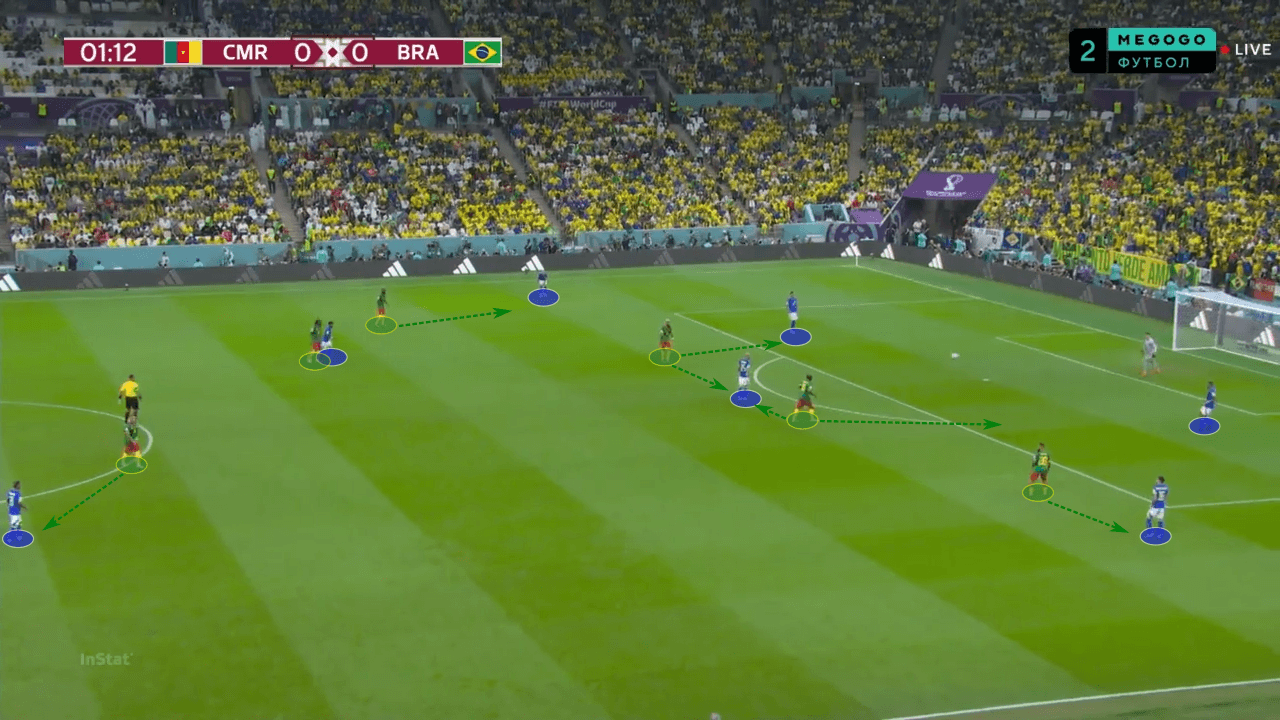
Once a side was selected, they often looked to cut the pitch in half and congest the Seleção on one side. In the example below, after Militão initiates the build-up on their right side, Cameroon shift their high block over to that side. Aboubakar remains deeper on Fabinho while Choupo-Moting advances on the ball carrier. Ngamaleu jumped on Dani Alves and the remaining players followed along.
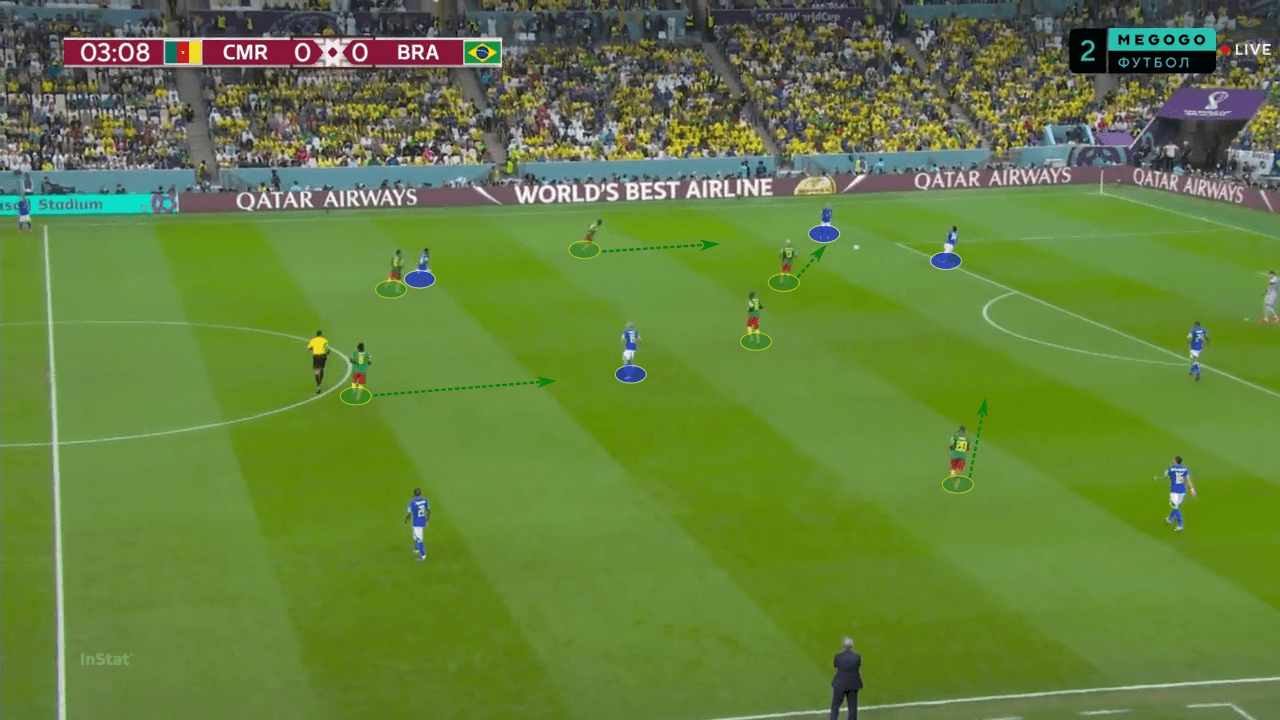
If Brazil tried to recycle and go the other way, Cameroon were quite good at shifting their block and using the respective winger to delay the Seleção’s progression. In the example below, by pressuring Bremer at an angle, Mbeumo keeps Telles from receiving the ball. This movement delays the opposition’s build-up and buys time for his teammates to shift across.
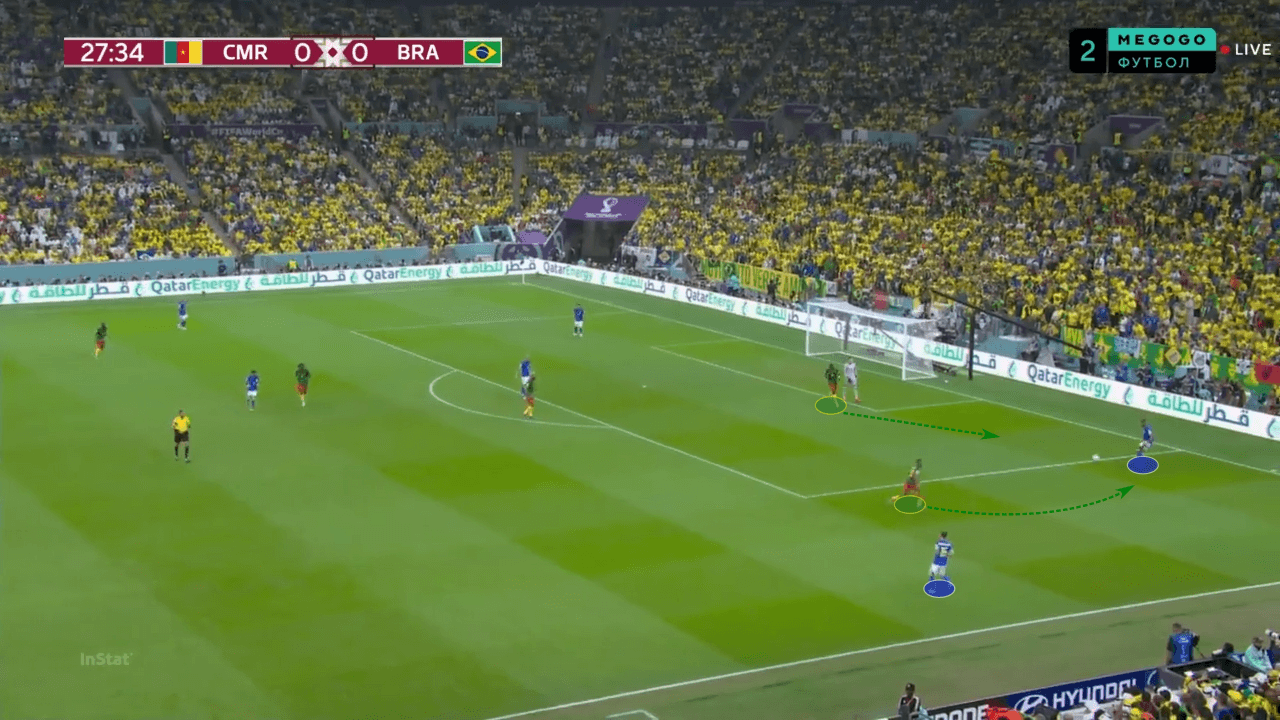
Cameroon were very conscious of their defensive behaviour. Whether it was time to defend in a high, mid, or low block, they recognised it and did it well. In a mid-block, they reverted to a more compact 4-2-4. The two centre-forwards now sat in front of the midfield rather than advancing on the centre-backs. The wingers also sat relatively narrow until Brazil played it to the wide areas. This congested the midfield and kept the Seleção from any effective interior play.
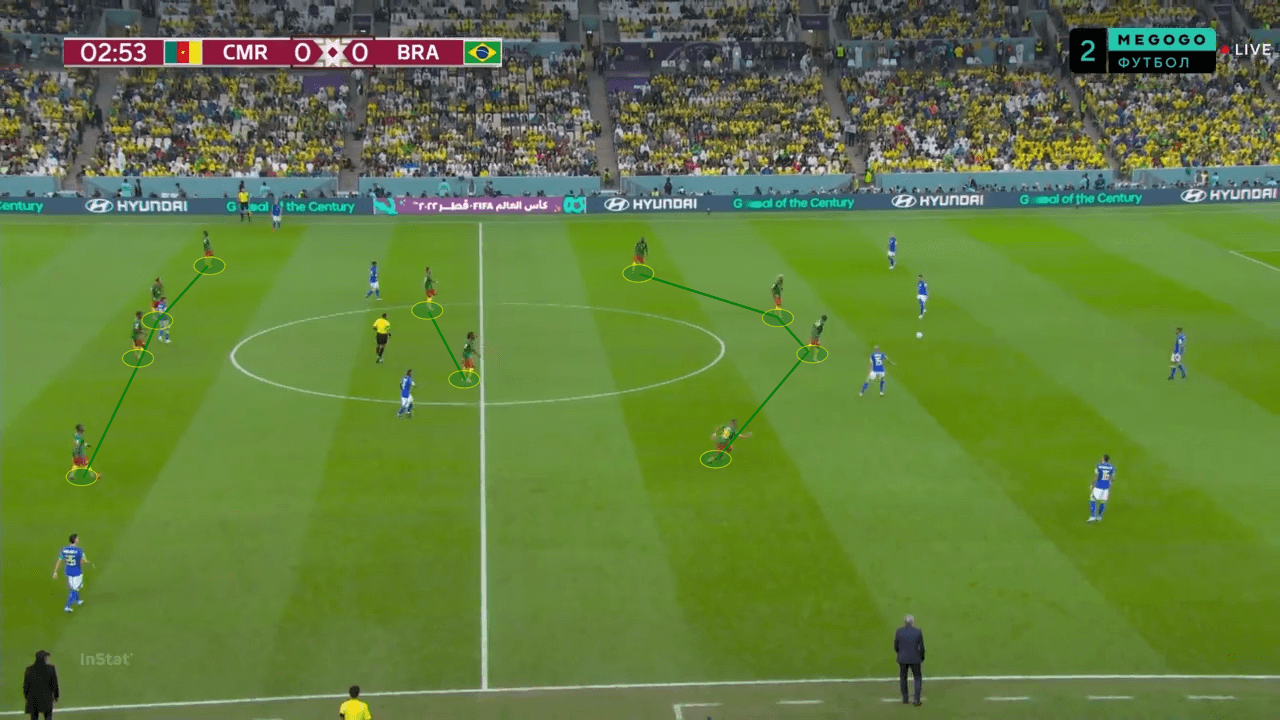
As Brazil patiently recycled possession looking for an opening, Cameroon were very patient to remain compact and organised. The wingers had clear man-marking roles on Brazil’s fullbacks, and so did Cameroon’s fullbacks on Brazil’s wingers. In the midfield, Anguissa remained on Rodrygo while Kunde marked Fred. Again, Choupo-Moting was tasked with marking Fabinho.
In the image below, their structure is quite disorganised as players have followed their man-marking tasks. While Brazil attempted to create space through movement off the ball, the Indomitable Lions were quite consistent with their man-marking system.
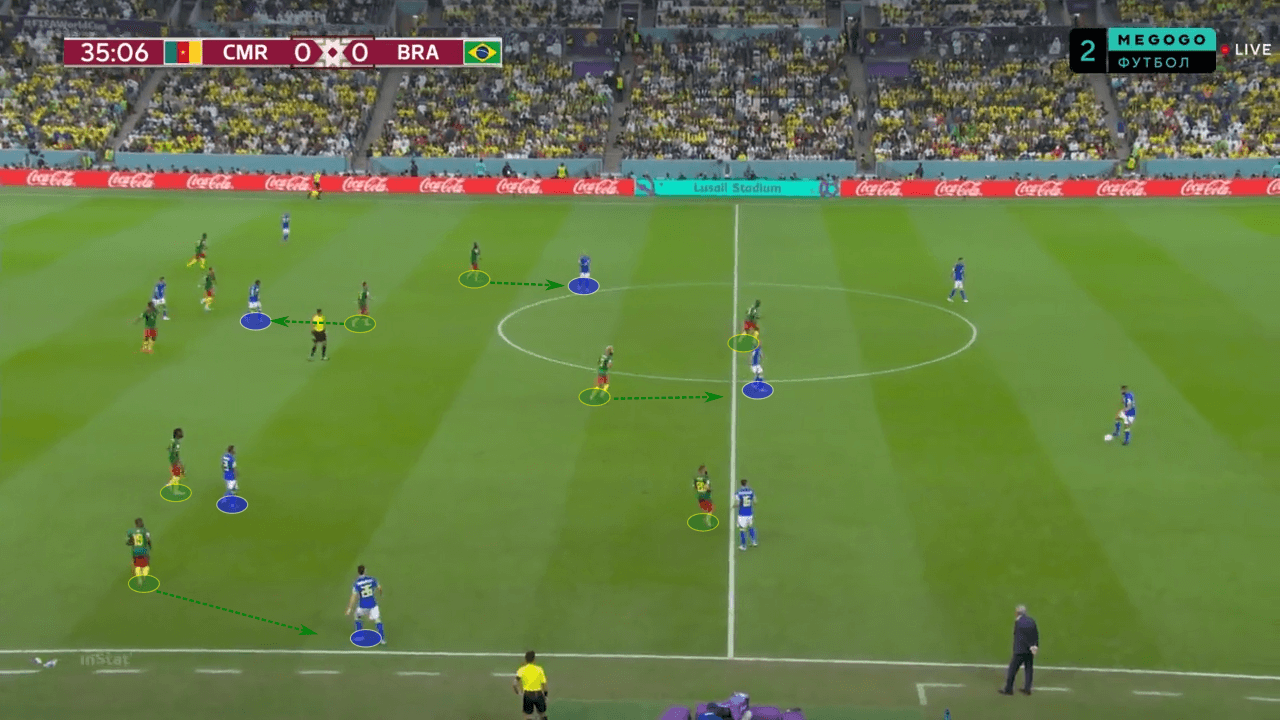
Brazil’s solutions
As the match went on, Tite’s men offered a few solutions to the puzzle posed by Song. While these helped them progress with more efficiency and create higher quality chances, they obviously did not result in goals. After all, Brazil had a total xG of 3.17 from 20 shots. The chances started coming as the match progressed, but the South Americans failed to capitalise on them.
Nonetheless, these solutions are still worth looking at. The first involves Dani Alves, a controversial inclusion in Brazil’s squad. The 39-year-old started moving into the midfield with the objective of creating numerical superiority in central areas and capitalising on the plus-one advantage.
This movement inside was combined with Antony dropping deep. Tolo, Cameroon’s left-back, rarely followed Antony into his own half, so Antony was able to pin Cameroon’s winger wide and allow Alves to freely roam into the midfield. This happens in the instance below, and while Cameroon’s entire midfield shifts over, Rodrygo quietly roams to the opposite side and becomes an outlet.
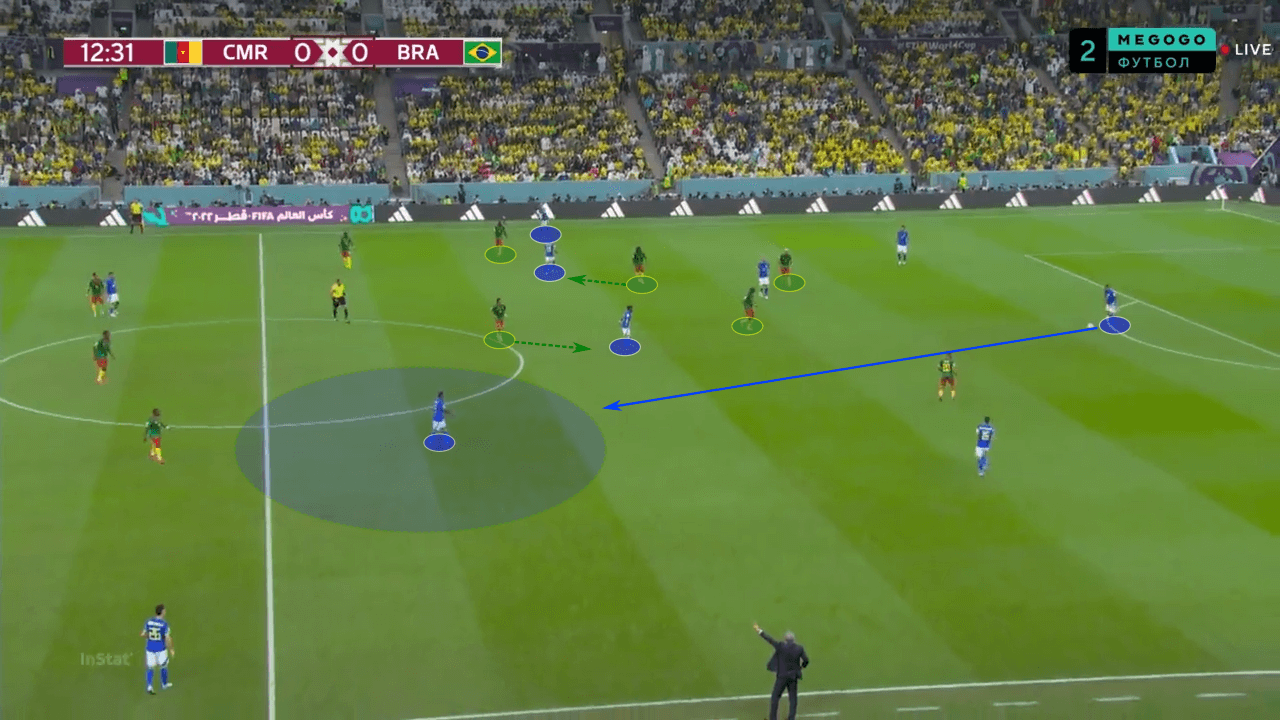
Another instance of this variation happened early in the second half. As Dani Alves has the ball, Antony drops deep and attracts Ngamaleu. As Alves enters the midfield, Anguissa comes forward to mark him, leaving Fred with space to receive inside Cameroon’s organisation.
However, in this specific instance, Fred takes a bad touch and immediately loses the ball after being pressured. This was a continuous trend in Brazil’s performance. While tactical solutions were created throughout the match, they failed to capitalise on them due to underwhelming individual performances all around.
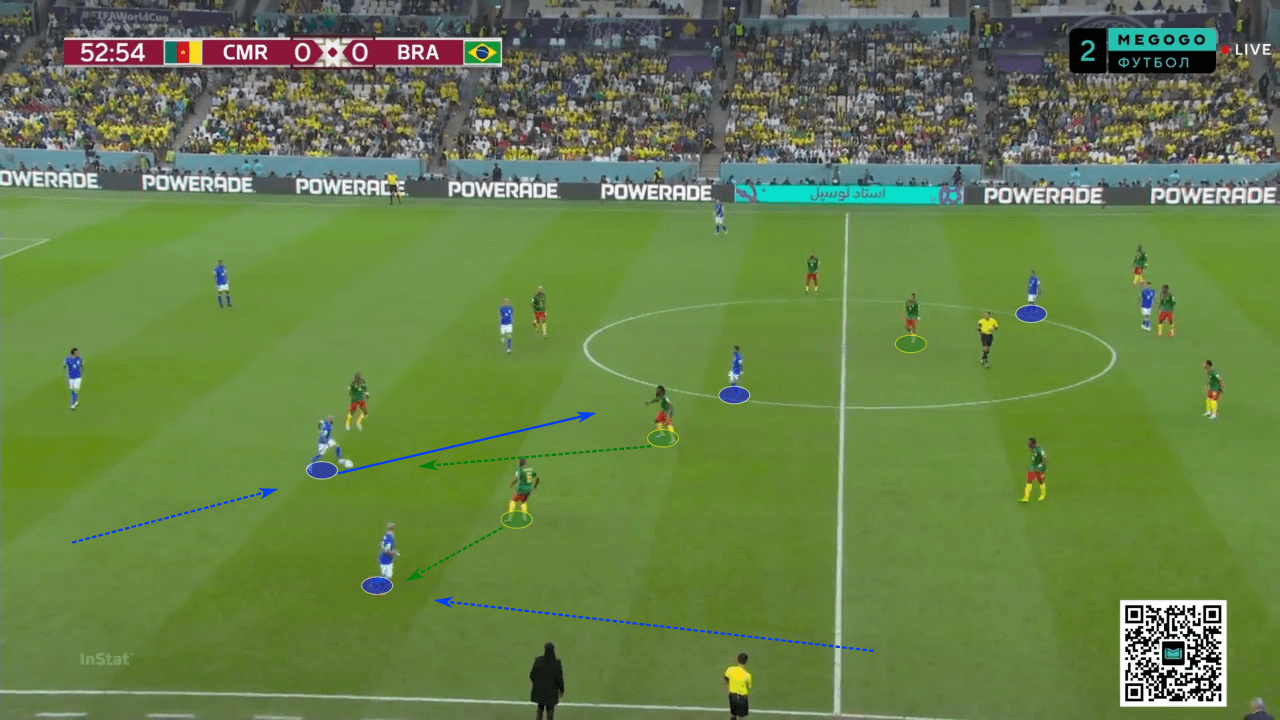
In the first half, the Seleção also found success through quick switches of play. In their mid-block, Cameroon looked to remain compact and focus their organisation on the ball’s side. This opened up opportunities as Brazil’s opposite winger always remained extremely wide. This was often the case with Martinelli, who received a few dangerous balls in the first 45 minutes.
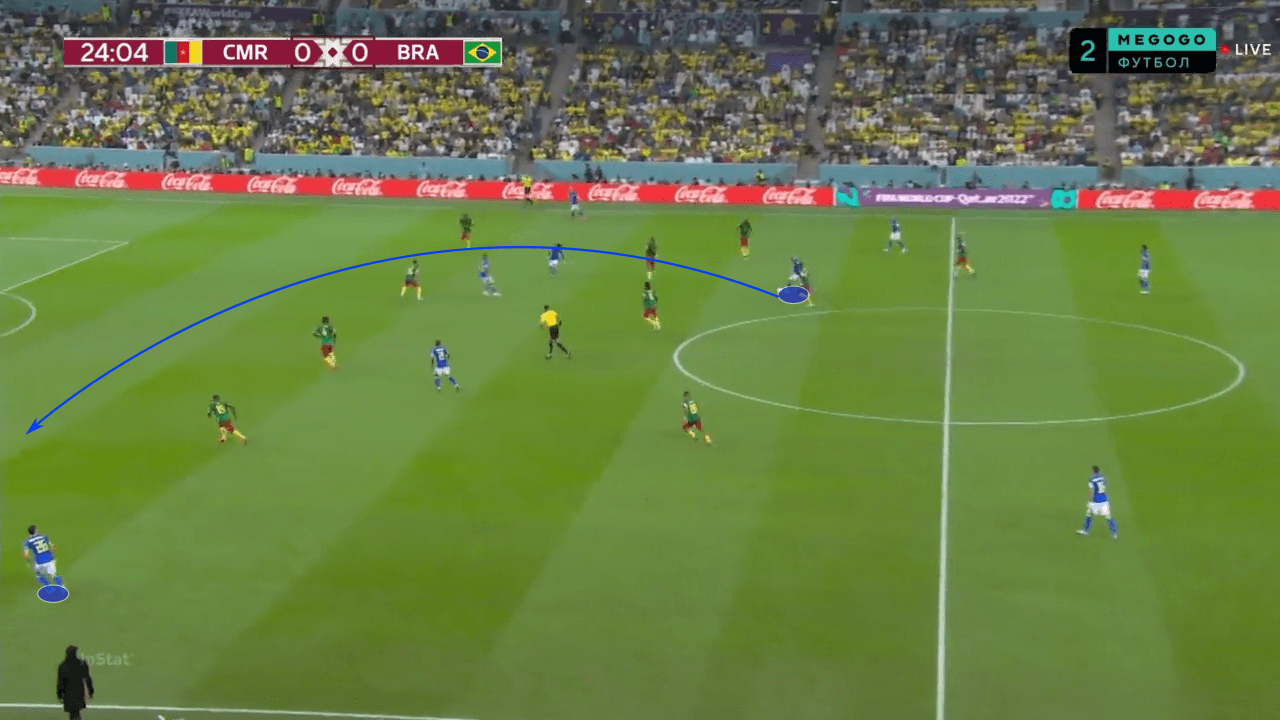
In the second half, the game became more stretched. Transition prevailed possession and spaces opened up. In these scenarios, Brazil were able to exploit this space through intelligent link-up play in the final third. This sort of combination going from the wide areas into the central areas of the final third happened a few times in the second half, as seen in the example below. Again though, Brazil were not clinical enough to take advantage of these opportunities.
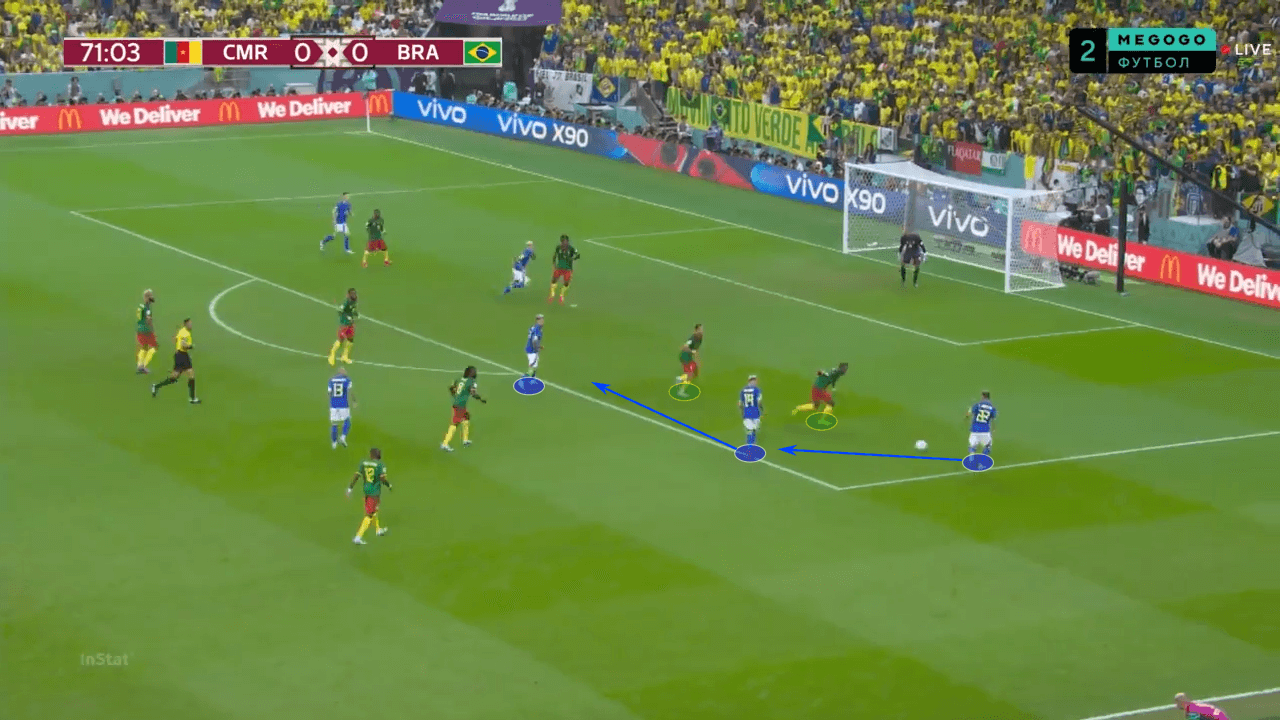
Gold is in transition
Cameroon had the ball far more times than they probably expected, but when they faced Brazil’s defensive organisation, they failed to cause any real danger. The African nation only had a total of six shots in the match, amounting to a low 0.44 xG. As usual, Brazil’s organisation in the defensive phase of the game was very secure.
This began in a high block, where Jesus tirelessly pressed the centre-backs. Rodrygo marked Anguissa while Fred was tasked with following Kunde. Fabinho was in charge of covering for them and tracking Choupo-Moting in case he dropped into the midfield. The wingers had more defensive duties as they tracked Cameroon’s attacking fullbacks.
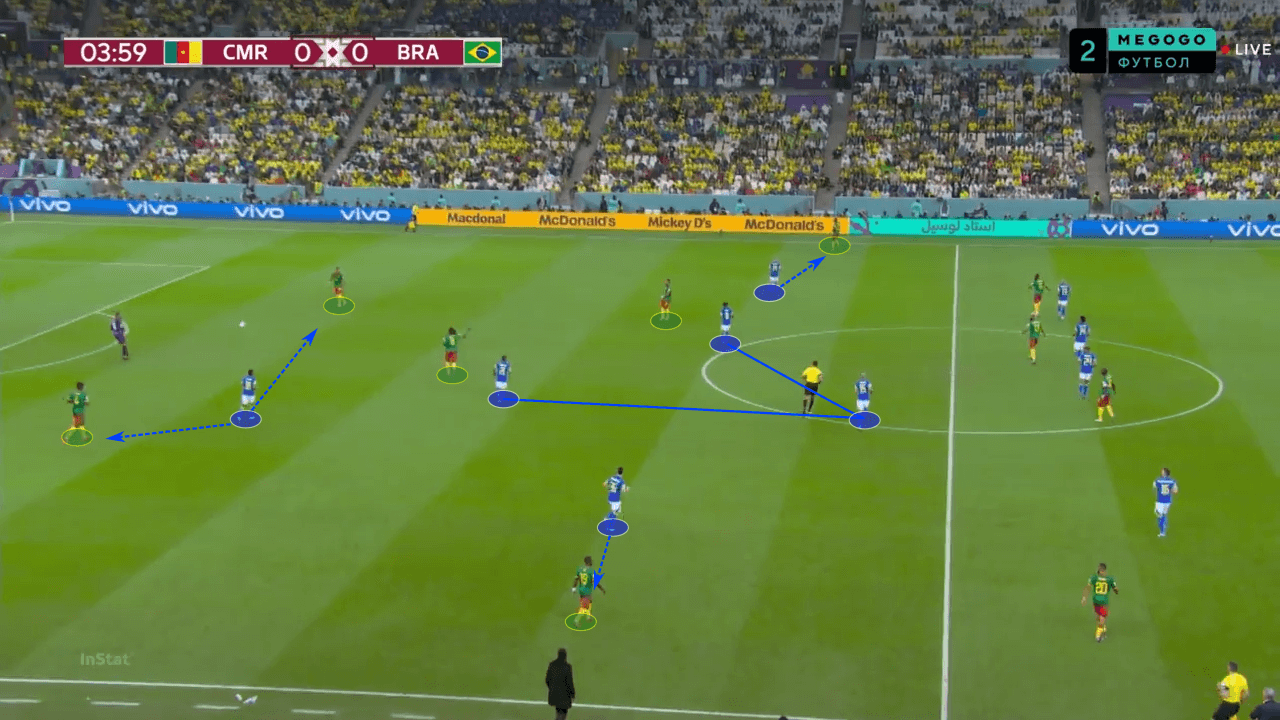
In a mid-block, these defensive duties in the wide areas became more obvious. The African nation’s fullbacks looked to push up extremely high while the wide players came inside. Martinelli and Antony were tasked with tracking them while Fabinho and Fred took care of Cameroon’s two midfielders. Rodrygo occasionally stayed up alongside Jesus in a 4-4-2, but as Cameroon progressed, he would track back as well.
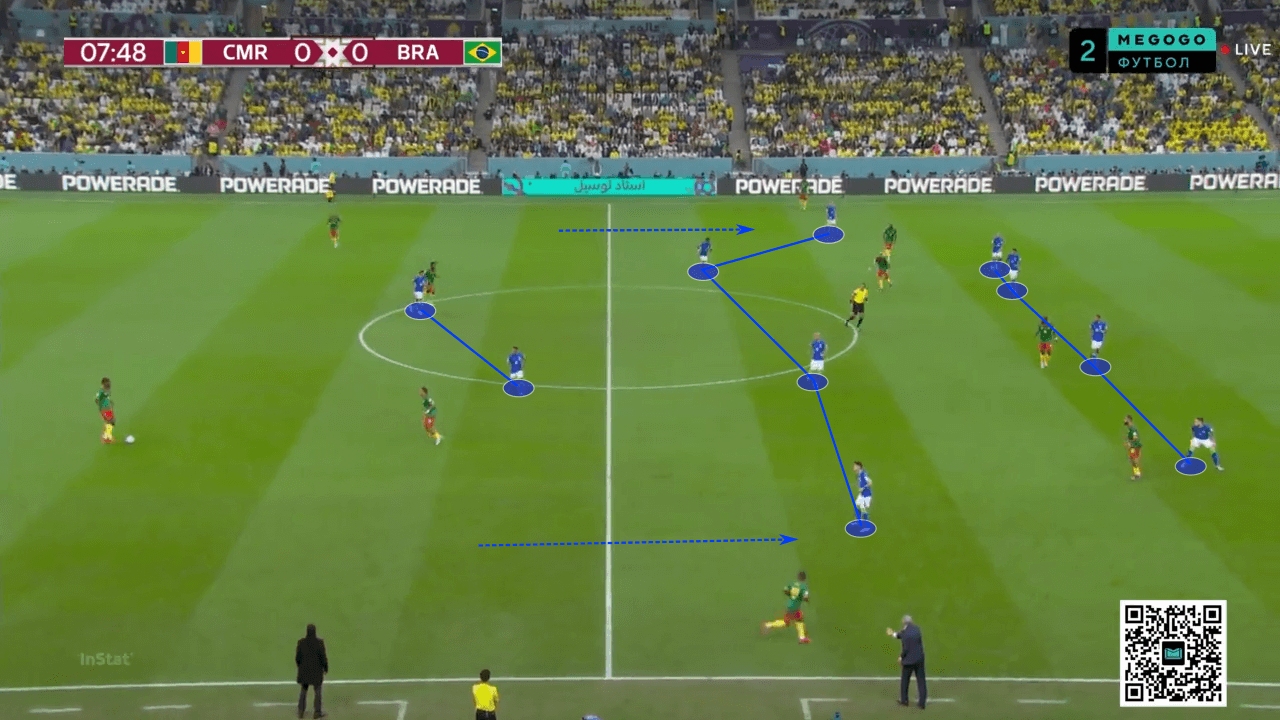
Cameroon found no success against a structured Brazilian defence. However, gold was found in the attacking transition. In the second half, Song’s men began finding success when exploiting the counter-attack. Although Brazil generally have a very good counter-pressing system, it was getting exposed in the last 45 minutes. The first instance took place around the 67th minute when Aboubakar played Ngamaleu into the space behind Marquinhos.
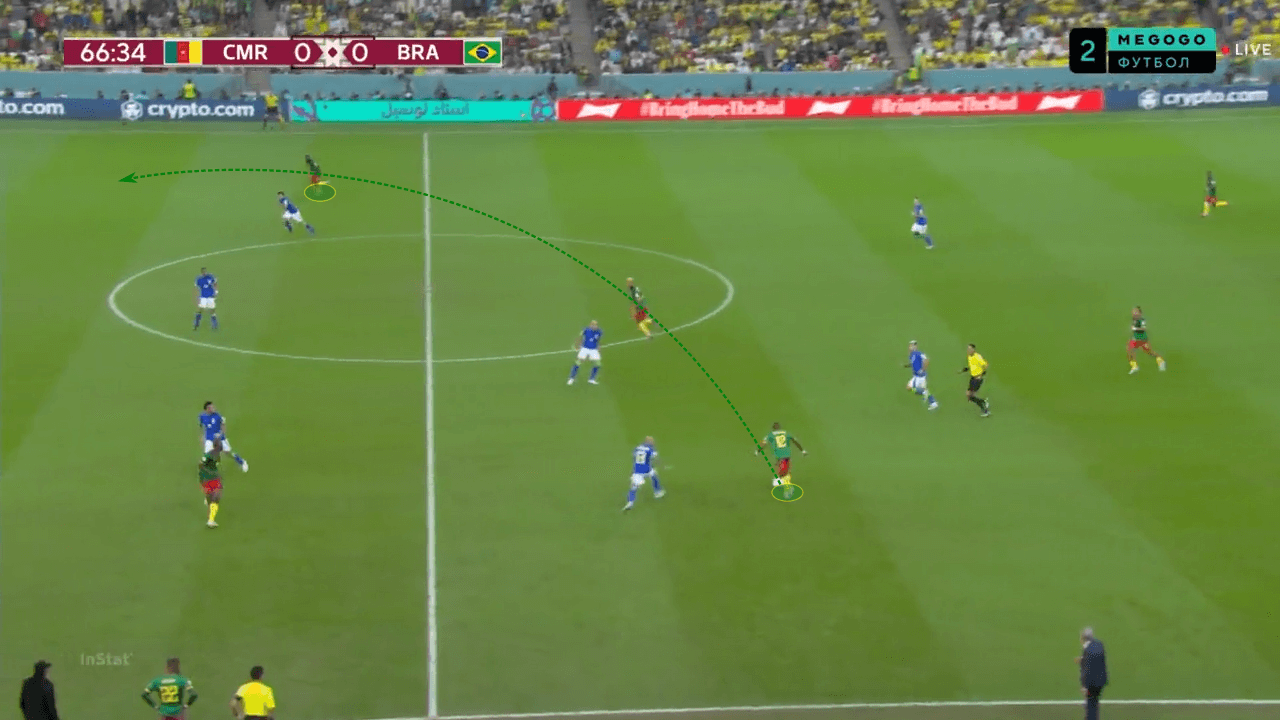
The real success, however, came in the 92nd minute. After recovering the ball in a low block, Cameroon quickly play out of pressure and into the midfield. Ntcham is then able to initiate the counter-attack and find Mbekeli on the right wing, who plays a perfect cross for Aboubakar to find the back of the net.
When attacking, Brazil are usually prepared for the counterattack with an attack-to-defend-like structure. Towards the end of the second half, after a frustrating performance throughout the match, they began to lose focus and give up spaces like this.
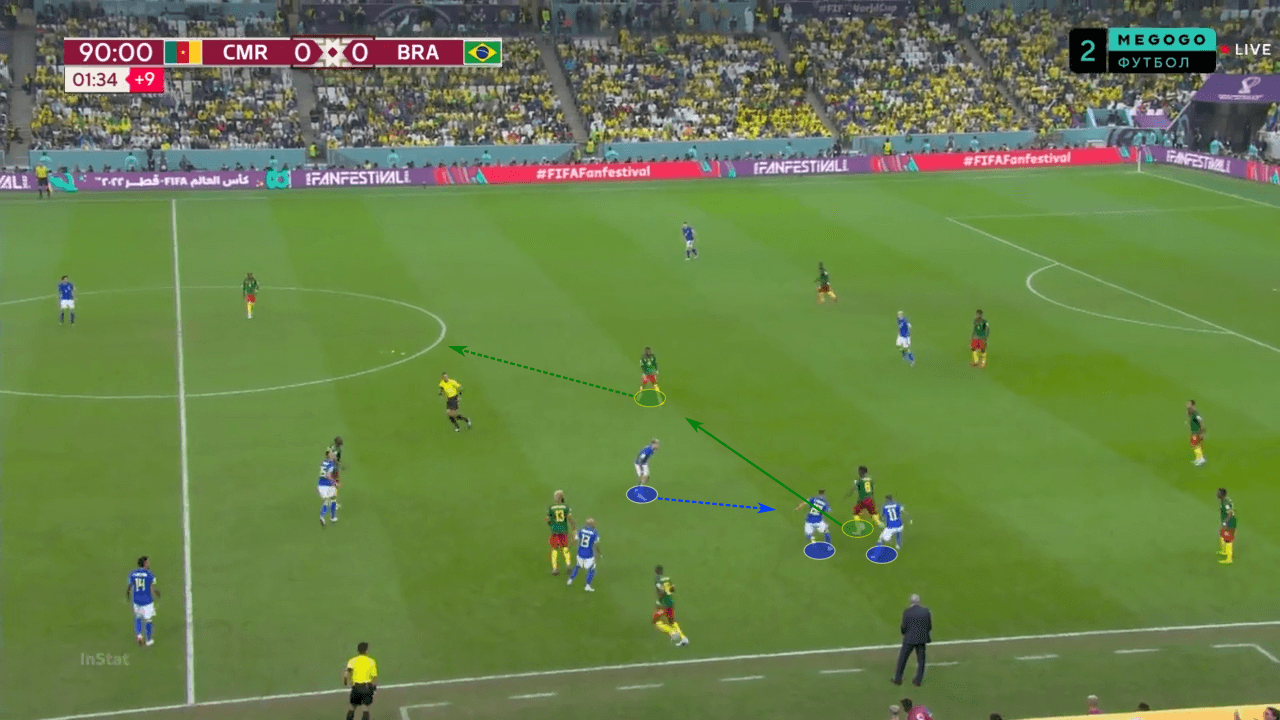
Conclusion
Brazil suffered a shocking loss to Cameroon in their final match of the group stage. While they were still able to qualify with a first-place finish, this result served as a wake-up call to Tite’s men. Some individual performances may also give Tite a lot to think about in the knockout stages. On the other hand, a lot of credit must be given to Cameroon after such resilience and patience.
While Cameroon say goodbye to the competition, Brazil will play South Korea in the round of 16. Neymar’s availability is still in question, along with Danilo, Alex Sandro, and now Alex Telles. With three of his four fullbacks seemingly out of action, Tite will have a lot of thinking to do. Should they advance to the quarter-final, these players should begin returning to action. Nonetheless, the path to the final will not be an easy one for the Seleção.





Comments